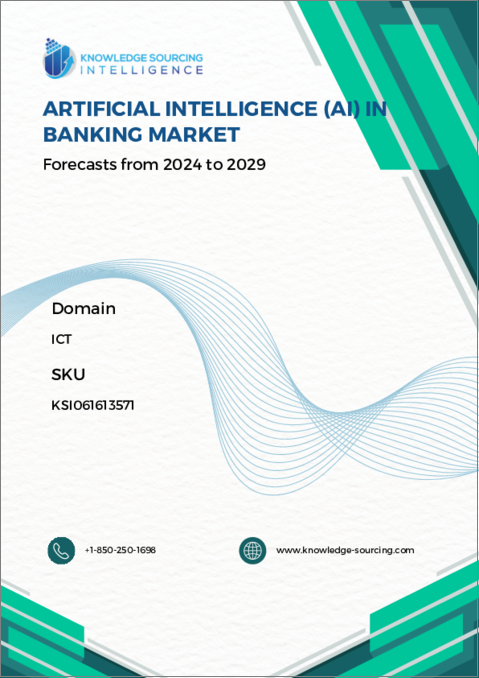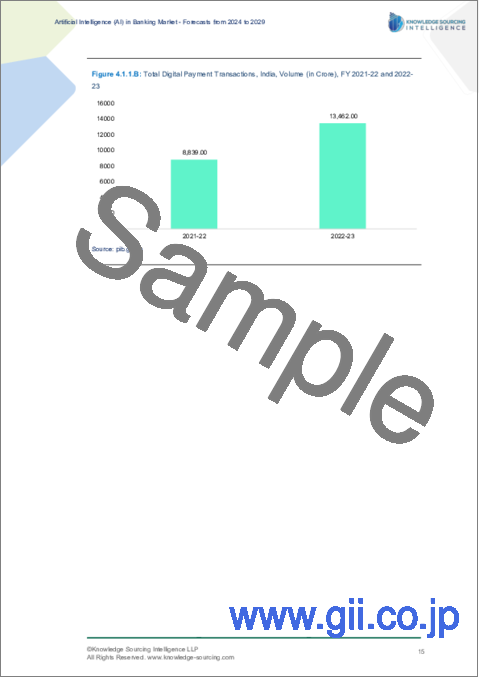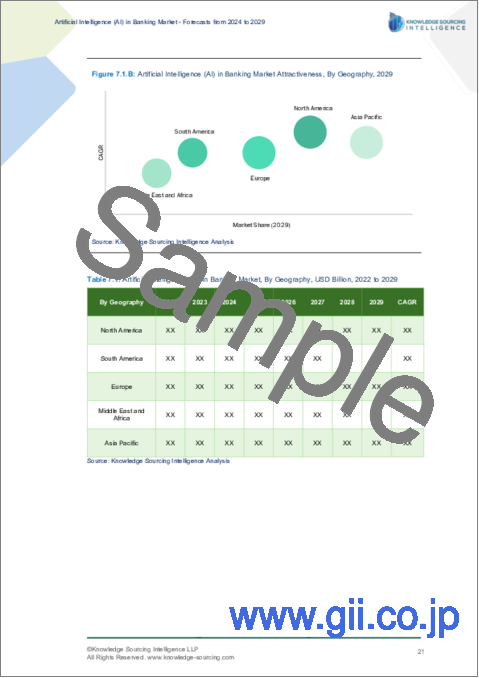|
|
市場調査レポート
商品コード
1604527
銀行業務向け人工知能 (AI) 市場:将来予測 (2024年~2029年)Artificial Intelligence (AI) In Banking Market - Forecasts from 2024 to 2029 |
||||||
カスタマイズ可能
|
|||||||
| 銀行業務向け人工知能 (AI) 市場:将来予測 (2024年~2029年) |
|
出版日: 2024年11月06日
発行: Knowledge Sourcing Intelligence
ページ情報: 英文 125 Pages
納期: 即日から翌営業日
|
全表示
- 概要
- 目次
銀行業務向け人工知能 (AI) 市場は55.53%のCAGRで成長し、2024年の173億8,300万米ドルから2029年には546億3,500万米ドルに達すると推定されます。
銀行分野では、AIまたは人工知能が重要な役割を果たすと考えられています。この分野では、AIベースのツールは、顧客サービスと経験をパーソナライズすることを含む複数の利点を提供します。また、さまざまなプロセスやシステムを自動化し、顧客サービス体験を豊かにすることもできます。AIベースのツールは、詐欺やマネーロンダリングのようなその他の違法活動の検知にも役立ちます。
AIベースの会計ソフトウェアなど、先端技術の適応が進むにつれ、手間のかからないオンラインバンキングやモバイルバンキングサービスへの需要が高まっています。
首尾一貫したテクノロジーへの投資を通じてAIを銀行と統合することで、銀行はデジタル上のメリットを獲得し、フィンテック企業との競争に打ち勝つことができます。
さらに、AIアルゴリズムはマネーロンダリング防止活動を数秒で実行します。そうでなければ、数時間から数日かかります。加えて、AIは発展の現代において人々の生活に不可欠なものとなっています。銀行はエンドユーザーの需要に応えるため、AIベースの技術を既存の技術と統合し始めています。市場の主な開拓は、顧客メリットの向上、リスク管理の強化、規制遵守によるものです。機密情報セキュリティの問題は市場拡大の妨げとなる可能性があり、銀行部門におけるAI統合によるデータセキュリティの展開は極めて重要となっています。
銀行業務向け人工知能 (AI) 市場の促進要因
- 顧客体験の増大
消費者は利便性とユーザーフレンドリーな体験を求めています。ATMは、そのアクセスのしやすさから大きな成功を収めています。顧客は自分の都合に合わせてお金を引き出すことができます。このため、顧客が自宅にいながらにしてすべての高度なサービスにアクセスできるように、このエクスペリエンスを強化するために銀行セクターにAIを導入するというイノベーションが生まれました。また、銀行関連の問題で消費者を支援することで、銀行のワークフローを合理化しました。
例えば、2024年4月、セールスフォースは、銀行がより生産的に取引紛争に対処できるよう、アインシュタイン1プラットフォーム上に構築されたAI搭載の機能を発表しました。これらの機能には、取引紛争管理やEinstein Copilot Banking Actionsなどがあり、銀行段階からの取引情報とセールスフォースからの顧客情報を組み合わせることで、手作業を電子化し、エラーを減らし、顧客とのコミュニケーションを進展させる。Einstein Copilot Banking Actionsは、顧客の詳細情報の更新や電子メールによるパーソナライズ・コミュニケーションなどの作業を電子化します。
さらに、AIを活用することで、銀行は大量のデータを記録的なスピードで管理し、そこから貴重な洞察を得ることができます。AIボット、デジタル決済アドバイザー、生体認証による不正検知メカニズムなどの機能により、大規模な顧客ベースにわたってより質の高いサービスを提供することが可能になります。これらすべてが、収益の向上、コストの削減、高収益につながります。チャボットは銀行業務向け人工知能 (AI) の最良の例の一つです。ボットが配置されれば、働く時間が決まっている人間とは異なり、24時間365日働くことができます。
銀行業務向け人工知能 (AI) 市場の地理的展望
- 銀行業務向け人工知能 (AI) 市場では、北米が大きなシェアを占めると予測されています。
北米は、データ分析、AI、ブロックチェーン、IoT、クラウドコンピューティング、あらゆるインターネットベースのサービスなど、急速に進化するデジタル技術の利用が増加していることから、成長が見込まれています。
また、この地域は銀行業務向け人工知能 (AI) 業界で世界を支配すると予想されています。国連貿易開発会議の最新報告書によると、セルラー接続を備えたIoTデバイスは2024年の3億2,060万台のIoT接続から、北米では2029年までに5億7,350万台のIoT接続を占めるまでに成長すると予想されています。これにより、銀行サービスにおけるAIを消費者に提供する要件が高まり、今後数年間の市場拡大を後押しします。
さらに、銀行部門のデジタル化の進展により、同地域市場の成長が見込まれています。また、銀行を含む様々な分野でのAIの採用を促進する政府の政策やイニシアティブ、米国やカナダなどの新興諸国での革新的な技術の採用が予測期間中に見込まれています。
当レポートを購入する理由
- 洞察に満ちた分析:顧客セグメント、政府政策と社会経済要因、消費者の嗜好、産業別、その他のサブセグメントに焦点を当て、主要地域だけでなく新興地域もカバーする詳細な市場考察を得ることができます。
- 競合情勢:世界の主要企業が採用している戦略的作戦を理解し、適切な戦略による市場浸透の可能性を理解することができます。
- 市場促進要因と将来動向:ダイナミックな要因と極めて重要な市場動向、そしてそれらが今後の市場展開をどのように形成していくかを探ります。
- 行動可能な提言:ダイナミックな環境の中で、新たなビジネスストリームと収益を発掘するための戦略的意思決定に洞察を活用します。
- 幅広い利用者に対応:新興企業、研究機関、コンサルタント、中小企業、大企業にとって有益で費用対効果が高いです。
どのような用途で利用されていますか?
業界・市場考察、事業機会評価、製品需要予測、市場参入戦略、地理的拡大、設備投資決定、規制の枠組みと影響、新製品開発、競合の影響
分析範囲
- 過去のデータと予測 (2022~2029年)
- 成長機会、課題、サプライチェーンの展望、規制枠組み、顧客行動、動向分析
- 競合企業のポジショニング・戦略・市場シェア分析
- 収益成長率と予測分析:セグメント別・地域別 (国別)
- 企業プロファイリング (戦略、製品、財務情報、主な動向など)
銀行業務向け人工知能 (AI) 市場は以下のセグメントに分析されます:
ソリューション別
- ハードウェア
- ソフトウェア
- サービス
用途別
- カスタマーサービス
- ロボアドバイザー
- 汎用/予測分析
- サイバーセキュリティ
- 直接学習
地域別
- 北米
- 米国
- カナダ
- メキシコ
- 南米
- ブラジル
- アルゼンチン
- その他
- 欧州
- ドイツ
- フランス
- 英国
- イタリア
- スペイン
- その他
- 中東中東・アフリカ
- サウジアラビア
- UAE
- イスラエル
- その他
- アジア太平洋
- 中国
- 日本
- 韓国
- インド
- タイ
- 台湾
- インドネシア
- その他
目次
第1章 イントロダクション
- 市場概要
- 市場の定義
- 分析範囲
- 市場セグメンテーション
- 通貨
- 前提条件
- 基準年と予測年のタイムライン
- ステークホルダーにとっての主なメリット
第2章 分析手法
- 分析デザイン
- 分析プロセス
第3章 エグゼクティブサマリー
- 主な調査結果
第4章 市場力学
- 市場促進要因
- 市場抑制要因
- ポーターのファイブフォース分析
- 業界のバリューチェーン分析
- アナリストの見解
第5章 銀行業務向け人工知能 (AI) 市場:ソリューション別
- イントロダクション
- ハードウェア
- ソフトウェア
- サービス
第6章 銀行業務向け人工知能 (AI) 市場:用途別
- イントロダクション
- 顧客サービス
- ロボアドバイザー
- 汎用/予測分析
- サイバーセキュリティ
- 直接学習
第7章 銀行業務向け人工知能 (AI) 市場:地域別
- イントロダクション
- 北米
- ソリューション別
- 用途別
- 国別
- 南米
- ソリューション別
- 用途別
- 国別
- 欧州
- ソリューション別
- 用途別
- 国別
- 中東・アフリカ
- ソリューション別
- 用途別
- 国別
- アジア太平洋
- ソリューション別
- 用途別
- 国別
第8章 競合環境と分析
- 主要企業と戦略分析
- 市場シェア分析
- 企業合併・買収 (M&A)、合意、事業協力
- 競合ダッシュボード
第9章 企業プロファイル
- Zest AI
- IBM
- Data Robot Inc.
- Personetics Technologies
- Kensho Technologies, LLC
- Wipro
- Intel
- SAP
- Temenos
- SAS
- Abe AI (Yodlee, Inc.)
- OSP Labs
Artificial intelligence (AI) in the banking market is estimated to grow at a CAGR of 55.53% to attain US$54.635 billion in 2029, increasing from US$17.383 billion in 2024.
In the banking sector, AI or artificial intelligence is set to play a critical role. In this sector, AI-based tools offer multiple benefits, which include personalizing customer service and experience. They can also automate various processes and systems, enriching the customer service experience. AI-based tools can also help detect fraud and other illegal activities, like money laundering.
The increasing adaptation of advanced technologies, such as AI-based accounting software, has increased the demand for hassle-free online and mobile banking services.
By integrating AI with banks through investment in coherent technology, banks can gain digital benefits and compete with FinTech companies.
Further, the AI algorithm performs money-laundering prevention activities in seconds. Otherwise, it will take hours to days. In addition, AI has become an integral part of people's lives in the modern era of development. Banks have begun integrating AI-based technology with their existing technology to meet end-user demand. Major developments in the market are due to enhancing customer benefits, increasing risk management, and following regulatory compliance. Sensitive information security issues can hinder market expansion, making the deployment of data security with AI integration in the banking sector crucial.
Artificial Intelligence (AI) in banking market drivers
- Increasing customer experience
Consumers demand convenience and a user-friendly experience. ATMs are a huge success because of their ease of access. Customers can withdraw money at their own convenience. This led to the innovation of bringing AI into the banking sector to enhance this experience so customers can access all the advanced services from the ease of their homes. It also streamlined the bank's workflow by assisting its consumers with banking-related difficulties.
For instance, in April 2024, Salesforce presented AI-powered capabilities built on the Einstein 1 Platform to help banks in dealing with transaction disputes more productively. These capabilities, including Transaction Dispute Management and Einstein Copilot Banking Actions, combine transaction information from banking stages with client information from Salesforce, computerizing manual errands, decreasing errors, and progressing client communications. The AI-powered handle streamlines the dispute process, whereas Einstein Copilot Banking Actions computerizes errands like updating client details and personalization communication via email.
Additionally, with AI, banks can manage large amounts of data at record speed and drive valuable insights from them. Features such as AI bots, digital payment advisors, and biometric fraud detection mechanisms enable a higher quality of service across a large customer base. All of this leads to higher revenue, lower costs, and high profits. Chabots are one of the best examples of AI in the banking industry. Once the bots are positioned, they can work 24*7, unlike humans, who have fixed timings to work on.
Artificial Intelligence (AI) in the banking market geographical outlook
- North America is forecasted to hold a major share of the Artificial Intelligence (AI) in the banking market.
North America is anticipated to grow due to the rising utilization of rapidly evolving digital technologies such as data analytics, AI, blockchain, IoT, cloud computing, and all Internet-based services in the region.
This region is also expected to dominate the global AI in the banking industry. According to the latest report from the United Nations Conference on Trade and Development, IoT devices with cellular connections are expected to grow from 320.6 million IoT connections in 2024 to account for 573.5 million IoT connections by 2029 in North America. This will increase the requirement to provide consumers with AI in Bank services, propelling the market expansion in the coming years.
Moreover, the regional market is expected to witness growth due to the increasing digitization of the banking sector. In addition, government policies and initiatives to promote the adoption of AI in various sectors, including banks, and the adoption of innovative technologies in developing countries such as the United States and Canada are expected during the forecast period.
Reasons for buying this report:-
- Insightful Analysis: Gain detailed market insights covering major as well as emerging geographical regions, focusing on customer segments, government policies and socio-economic factors, consumer preferences, industry verticals, other sub- segments.
- Competitive Landscape: Understand the strategic maneuvers employed by key players globally to understand possible market penetration with the correct strategy.
- Market Drivers & Future Trends: Explore the dynamic factors and pivotal market trends and how they will shape up future market developments.
- Actionable Recommendations: Utilize the insights to exercise strategic decision to uncover new business streams and revenues in a dynamic environment.
- Caters to a Wide Audience: Beneficial and cost-effective for startups, research institutions, consultants, SMEs, and large enterprises.
What do businesses use our reports for?
Industry and Market Insights, Opportunity Assessment, Product Demand Forecasting, Market Entry Strategy, Geographical Expansion, Capital Investment Decisions, Regulatory Framework & Implications, New Product Development, Competitive Intelligence
Report Coverage:
- Historical data & forecasts from 2022 to 2029
- Growth Opportunities, Challenges, Supply Chain Outlook, Regulatory Framework, Customer Behaviour, and Trend Analysis
- Competitive Positioning, Strategies, and Market Share Analysis
- Revenue Growth and Forecast Assessment of segments and regions including countries
- Company Profiling (Strategies, Products, Financial Information, and Key Developments among others)
The Artificial Intelligence (AI) in the banking market is analyzed into the following segments:
By Solution
- Hardware
- Software
- Services
By Application
- Customer Service
- Robot Advice
- General purpose/Predictive Analysis
- Cyber Security
- Direct Learning
By Geography
- North America
- USA
- Canada
- Mexico
- South America
- Brazil
- Argentina
- Others
- Europe
- Germany
- France
- United Kingdom
- Italy
- Spain
- Others
- Middle East and Africa
- Saudi Arabia
- UAE
- Israel
- Others
- Asia Pacific
- China
- Japan
- South Korea
- India
- Thailand
- Taiwan
- Indonesia
- Others
TABLE OF CONTENTS
1. INTRODUCTION
- 1.1. Market Overview
- 1.2. Market Definition
- 1.3. Scope of the Study
- 1.4. Market Segmentation
- 1.5. Currency
- 1.6. Assumptions
- 1.7. Base and Forecast Years Timeline
- 1.8. Key benefits for the stakeholders
2. RESEARCH METHODOLOGY
- 2.1. Research Design
- 2.2. Research Process
3. EXECUTIVE SUMMARY
- 3.1. Key Findings
4. MARKET DYNAMICS
- 4.1. Market Drivers
- 4.2. Market Restraints
- 4.3. Porter's Five Forces Analysis
- 4.3.1. Bargaining Power of Suppliers
- 4.3.2. Bargaining Power of Buyers
- 4.3.3. The Threat of New Entrants
- 4.3.4. Threat of Substitutes
- 4.3.5. Competitive Rivalry in the Industry
- 4.4. Industry Value Chain Analysis
- 4.5. Analyst View
5. AI IN BANKING MARKET BY SOLUTION
- 5.1. Introduction
- 5.2. Hardware
- 5.3. Software
- 5.4. Services
6. AI IN BANKING MARKET BY APPLICATION
- 6.1. Introduction
- 6.2. Customer Service
- 6.3. Robot Advice
- 6.4. General Purpose/Predictive Analysis
- 6.5. Cyber Security
- 6.6. Direct Learning
7. AI IN BANKING MARKET BY GEOGRAPHY
- 7.1. Introduction
- 7.2. North America
- 7.2.1. By Solution
- 7.2.2. By Application
- 7.2.3. By Country
- 7.2.3.1. United States
- 7.2.3.2. Canada
- 7.2.3.3. Others
- 7.3. South America
- 7.3.1. By Solution
- 7.3.2. By Application
- 7.3.3. By Country
- 7.3.3.1. Brazil
- 7.3.3.2. Argentina
- 7.3.3.3. Others
- 7.4. Europe
- 7.4.1. By Solution
- 7.4.2. By Application
- 7.4.3. By Country
- 7.4.3.1. Germany
- 7.4.3.2. France
- 7.4.3.3. United Kingdom
- 7.4.3.4. Italy
- 7.4.3.5. Spain
- 7.4.3.6. Others
- 7.5. Middle East and Africa
- 7.5.1. By Solution
- 7.5.2. By Application
- 7.5.3. By Country
- 7.5.3.1. Saudi Arabia
- 7.5.3.2. UAE
- 7.5.3.3. Israel
- 7.5.3.4. Others
- 7.6. Asia Pacific
- 7.6.1. By Solution
- 7.6.2. By Application
- 7.6.3. By Country
- 7.6.3.1. China
- 7.6.3.2. Japan
- 7.6.3.3. India
- 7.6.3.4. Australia
- 7.6.3.5. South Korea
- 7.6.3.6. Taiwan
- 7.6.3.7. Thailand
- 7.6.3.8. Indonesia
- 7.6.3.9. Others
8. COMPETITIVE ENVIRONMENT AND ANALYSIS
- 8.1. Major Players and Strategy Analysis
- 8.2. Market Share Analysis
- 8.3. Mergers, Acquisitions, Agreements, and Collaborations
- 8.4. Competitive Dashboard
9. COMPANY PROFILES
- 9.1. Zest AI
- 9.2. IBM
- 9.3. Data Robot Inc.
- 9.4. Personetics Technologies
- 9.5. Kensho Technologies, LLC
- 9.6. Wipro
- 9.7. Intel
- 9.8. SAP
- 9.9. Temenos
- 9.10. SAS
- 9.11. Abe AI (Yodlee, Inc.)
- 9.12. OSP Labs






